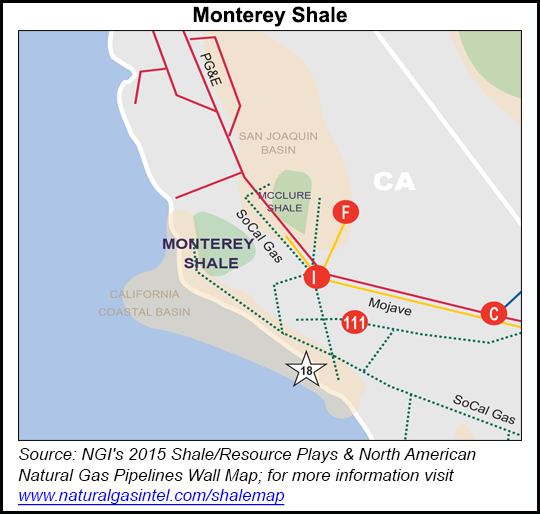E&P | NGI All News Access | NGI The Weekly Gas Market Report
Exploratory Wells in Monterey’s Deep Basin ‘Unlikely to be Successful,’ Says USGS
In the first means assessment of unconventional, technically recoverable resources in California’s Monterey formation in the deepest parts of the San Joaquin Basin, federal geologists have determined it contains an estimated 27 Bcf of natural gas, 21 million bbl of oil and 1 million bbl of natural gas liquids, smaller than previous estimates.

The U.S. Geological Survey (USGS) issued the unconventional resources report on Tuesday.
“The volume estimated in the new study is small, compared to previous USGS estimates of conventionally trapped recoverable oil in the Monterey formation in the San Joaquin Basin,” said officials. “Those earlier estimates were for oil that could come either from producing more Monterey oil from existing fields, or from discovering new, conventional resources in the Monterey formation.”
An assessment by USGS in 2003 of conventional resources in the Monterey estimated a mean of 121 million bbl of recoverable oil. The 2003 estimate of undiscovered continuous oil in the deep Monterey was 3-53 million bbl, with gas resources estimated at 5-72 Bcf and liquids of 0-3 million bbl.
The area of the potential continuous accumulation assessed in the new study was limited to where the Monterey is deeply buried, thermally mature and thought to be generating oil. USGS concluded that most of the petroleum that has originated from shale in the Monterey migrated from the source rock, “so there is probably relatively little recoverable oil or gas remaining there, and most exploratory wells in the deep basin are unlikely to be successful.”
According to geological data from more than 80 older wells that penetrated the deep formation, oil or gas retention in the Monterey shale source rock “is poor, probably because of natural fracturing, faulting and folding.” The resources “readily migrate from the deep Monterey formation to fill the many shallower conventional reservoirs in the basin, including some in fractured Monterey formation shale, and accounts for the prolific production there.”
The data suggest there aren’t a lot of unconventional resources in the Monterey’s deep basin, but “there are still substantial volumes of additional conventional oil and gas resources oil in the Monterey formation in the shallower conventional traps in the San Joaquin Basin, as indicated by earlier assessments,” USGS noted.
In 2012, USGS also assessed the potential volumes that could be added to reserves from increasing recovery in existing fields. The results of 2012 study suggested that a mean of about 3 billion bbl eventually could be added from Monterey reservoirs in conventional traps, mostly from diatomite rock.
Earlier this year, an initial assessment by scientists working with the California Council on Science and Technology concluded that the Monterey’s oil and gas resource potential was questionable (see Shale Daily, Jan. 15). An independent assessment two years ago also called into question the amount of oil and gas recoverable (see Shale Daily, Dec. 9, 2013).
© 2024 Natural Gas Intelligence. All rights reserved.
ISSN © 2577-9877 | ISSN © 1532-1266 | ISSN © 2158-8023 |
